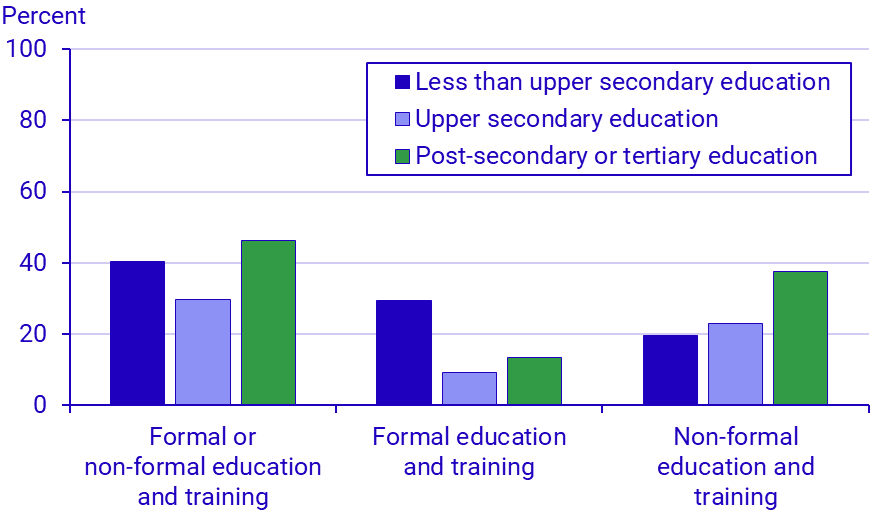Adult learning 2024
Adults with upper-secondary education participate the least in education and training
Statistical news from Statistics Sweden 2025-06-12 8.00
To meet changes in society and on the job market it is important for us to be well-educated and pursue lifelong learning. New statistics show that adults with upper secondary educational attainment level participate the least in education and training. People with higher education participate the most.
The statistics shed light on the proportion of the adult population, aged 18–69, who participate in education and training in a four-week period 2024. This includes formal and non-formal education and training.
- Formal education and training: education within the regular education system
- Non-formal education and training: teacher directed and organised education outside of the education system, such as employer sponsored education or recreational courses.
Among all adults, 40 percent participated in some form of education and training in a four-week period in 2024. 13 percent took part in formal education and training and 30 percent took part in non-formal education and training. The proportion who participated in education and training was generally higher among women than among men.
People who had upper secondary education as their highest level of education participated in education and training to a lesser extent than those with a lower or higher education level. People with lower secondary education participate more in formal education and training and those with post-secondary education participate more in non-formal education and training.
Proportion of the population, aged 18–69, who has participated in education and training in a four-week period. Average 2024.

Source: Statistics Sweden, Labour Force Surveys (LFS)
Formal education and training is most common among adults with less than upper secondary education
In the group of adults with only a lower secondary education, 30 percent took part in formal education and training. This includes adult education where young people without an upper secondary diploma can complete their secondary education and where immigrants take part in Swedish for immigrants or catch up on primary or secondary school within the municipal adult education.
In total, 41 percent of those without an upper secondary education participated in formal or non-formal education and training.
The most qualified participate the most in education and training
The higher education level that an occupation requires, the more common is non-formal education and training at work. The participation rate is the lowest among those who work in elementary occupations and the highest among those with occupations requiring advanced level of higher education. This confirms the pattern observed in other studies: the more resources in the form of education that a person already has, the more is invested in further education. This applies to both work-related education and training and education in leisure time.
This contributes to it being most common to participate in education and training among adults with post-secondary or tertiary education. In this group, 46 percent participated in education and training. Among adults with upper secondary education, the corresponding proportion was 30 percent. In this group, it was less common to participate in formal education and training than among those with a lower education and less common to participate in non-formal education and training than among those with a higher education.
Adult education common in Sweden compared to other countries
Apart from the Swedish results, the report also contains a chapter where the development from 2009 to 2024 in Sweden is compared to the development in the EU. There is also a chapter where Sweden is compared to the other EU countries. Some results for participation in education and training in a four-week period:
- In Sweden, it was twice as common to participate in education and training than in the EU as a whole and the participation was especially high among women. Sweden has the biggest difference between sexes of all the EU countries.
- The proportion of people in Sweden who participated in education and training has risen from 27 percent in 2009 to 40 percent in 2024.
- The proportion who participated in work-related non-formal education and training in Sweden in 2024 was among the highest in the EU.
- In 2024, Sweden had the highest proportion of unemployed people who participated in education and training. 53 percent of the unemployed in Sweden participated in education and training in 2024. The EU average was 20 percent.
Definitions and explanations
These statistics describe adults aged 18–69 and their participation in formal and non-formal education and training. Formal education and training is conducted within the regular education system, while non-formal education and training is teacher directed and organised education outside of the education system. A large part of the non-formal education and training is work-related. There is also non-formal education and training that is recreational, such as hobby courses and study circles.
These statistics are based on the Labour Force Surveys (LFS). The statistics make a complement to the register based statistics on participation in education and the international Adult Education Survey (AES).
Publication
Read more in the report Adult Learning 2024 (pdf, only in Swedish)
Feel free to use the facts from this statistical news but remember to state Source: Statistics Sweden.
